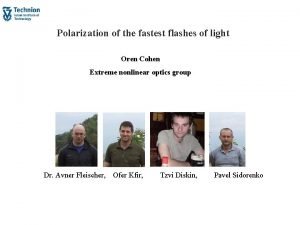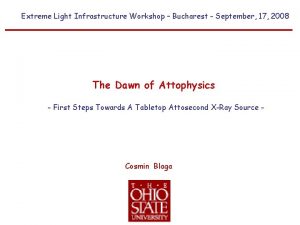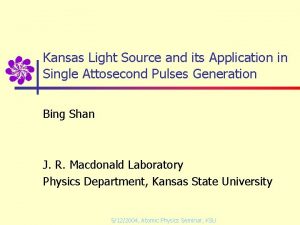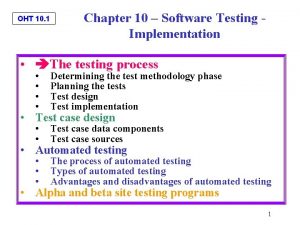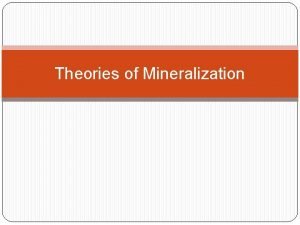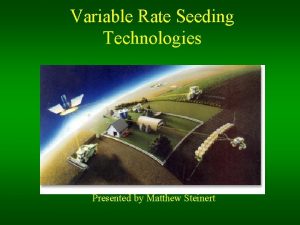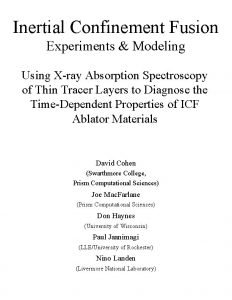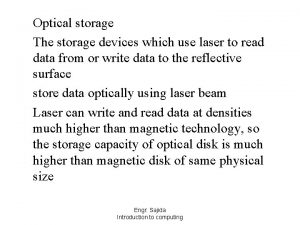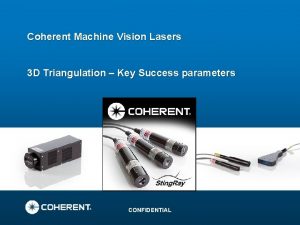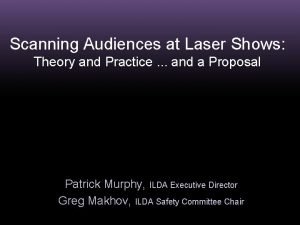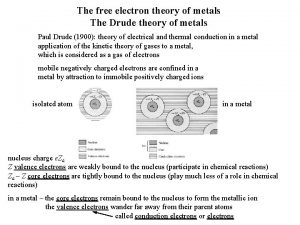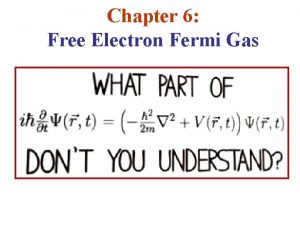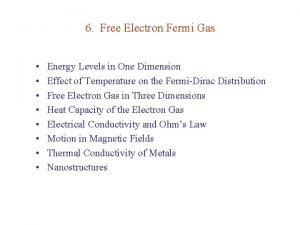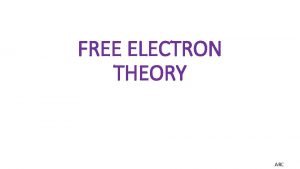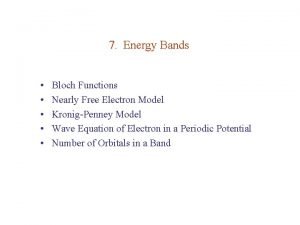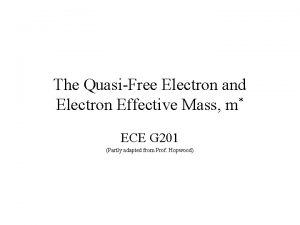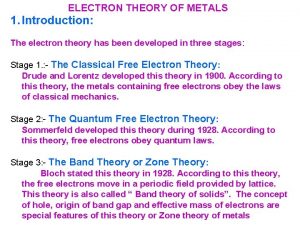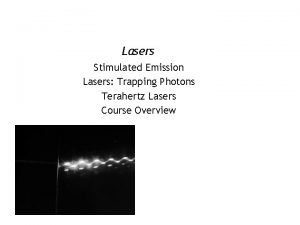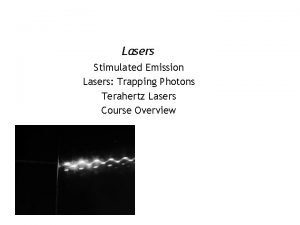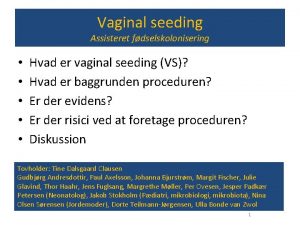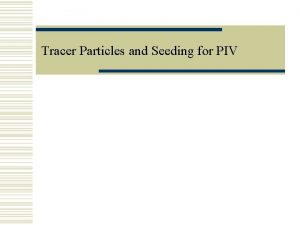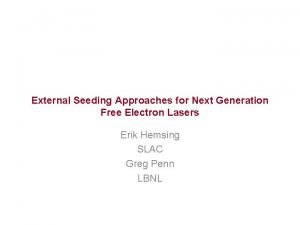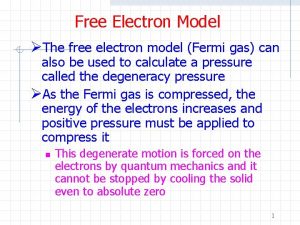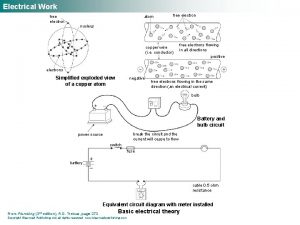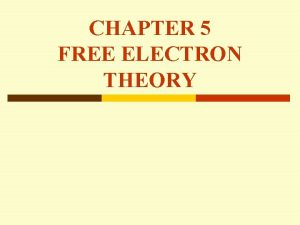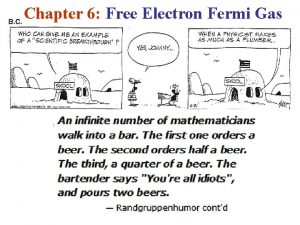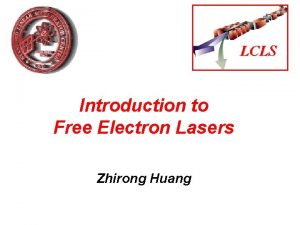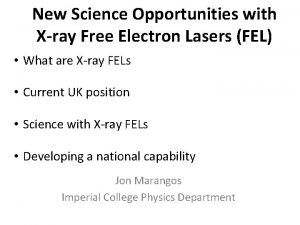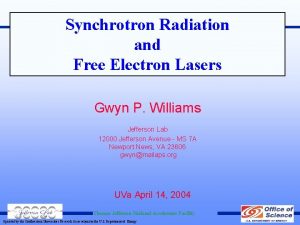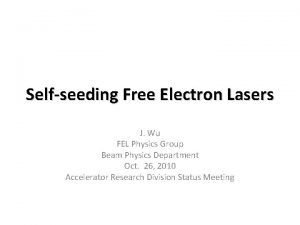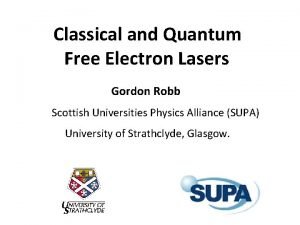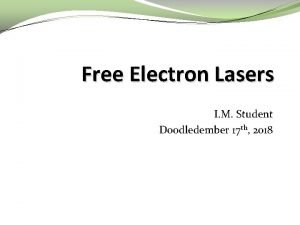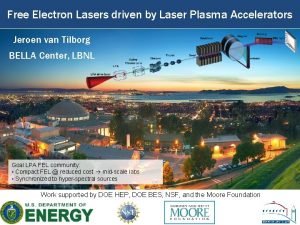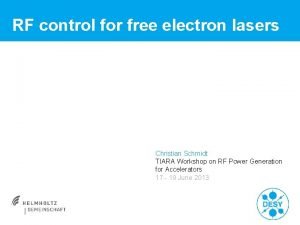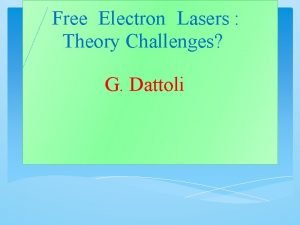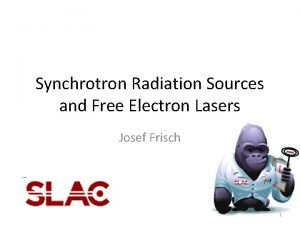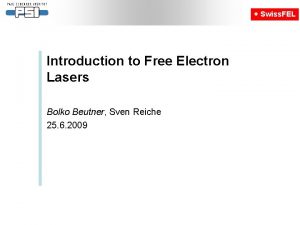HHG Seeding of ModeLocked Free Electron Lasers David






































- Slides: 38

HHG Seeding of Mode-Locked Free Electron Lasers David Dunning 8 th April 2009

Contents • Introduction • Mode generation and locking in a FEL. – How are discrete modes supported in a FEL? – Mode locking. • Amplification of an HHG seed without energy modulation. • Introducing energy modulation: mode-locked amplifier. – Analysis of mode-locking effect • Temporal slicing of a pre-filtered HHG seed. – Width of radiation envelope. – Increased output powers compared to unseeded (SASE) case.

Introduction • It will be shown how discrete modes can be supported in a FEL. • An explanation of how an electron beam energy modulation is used to ‘lock’ these modes. • This allows significantly shorter pulses to be generated than in other FEL schemes. • In SASE mode, these pulses are delivered in a train with the train length set by the electron bunch length and the envelope retaining characteristics of the start-up from noise. • Will show that an approximately gaussian envelope can be imposed onto this system through seeding. • Also, that significantly higher powers may be reached (than in the unseeded case) while retaining the pulse structure. • Currently investigating the possibility of reducing the length of the pulse train.

Free electron laser basic mechanism Accelerator-based photon source that operates through the transference of energy from a relativistic electron beam to a radiation field. y • Basic components S N S x B E N S vx v z N B field S N S Electron path N E field The undulator magnet introduces a transverse component to electron beam velocity, allowing it to couple with the transverse radiation electric field.

Resonant wavelength and slippage u r r e- The electrons move slightly less than the speed of light and travel a longer path due to transverse deflections – hence radiation slips ahead. Resonant wavelength is when radiation slips one radiation period ahead per undulator module – allowing continual energy transfer.

Resonant emission – electron bunching Gain energy Electrons bunch at resonant radiation wavelength – coherent process Lose energy Axial electron velocity r Some electrons gain energy from the field and some lose energy leading to bunching on the scale of the radiation wavelength -> this leads to coherent emission.

Types of FEL – low gain and high gain Low-gain FELs use a short undulator and a high-reflectivity optical cavity to increase the radiation intensity over many undulator passes. High-gain FELs use a much longer undulator section to reach high intensity in a single pass – hence are unrestricted in their wavelength range (at least by availability of suitable mirror materials.

Contents • Introduction • Mode generation and locking in a FEL. – How are discrete modes supported in a FEL? – Mode locking. • Amplification of an HHG seed without energy modulation. • Introducing energy modulation: mode-locked amplifier. – Analysis of mode-locking effect • Temporal slicing of a pre-filtered HHG seed. – Width of radiation envelope. – Increased output powers compared to unseeded (SASE) case.

Mode formation & locking in a SASE FEL amplifier* Borrow modelocking ideas from conventional lasers to synthesise ultrashort pulses. *

Cavity modes In a cavity only certain discrete frequencies are supported – those for which the cavity is an integer number of periods (No. of periods) 28 29 30 31 32 33 34 35 36 ‘cavity’ length

The ‘synthesised’ cavity is a repeated structure of short undulator modules and chicanes. The radiation slips ahead of the electrons in both. There are discrete modes supported for which this total slippage distance is equal to an integer number of periods. But, only some of these will fall within the undulator bandwidth. 28 29 30 31, 32, 33 l (slippage in undulator) δ (slippage in chicane) 34 35 36 s (total slippage)

Decreasing the length of the undulator sections is equivalent to increasing their gain bandwidth – this allows more modes to be supported and hence shorter pulses. (this will be referred to as increasing the ‘slippage enhancement factor’ (Se=s/ll) ). 28 29 30 30, 31, 32, 33, 34 l δ 34 35 36 s

Axial mode analysis It can be demonstrated that the axial modes generated are formally identical to those of a cavity. The ‘cavity’, however, is significantly shorter, so that only a few modes may fall under the gain bandwidth. This now allows coupling via a modulation introduced at a relatively large frequency. Similarities to DOK: V. N. Litvinenko, Nucl. Instrum. Methods Phys. Res. , Sect. A 304, 463 (1991).

Mode-Coupled SASE XUVFEL @ 12. 4 nm Spike FWHM ~ 1 fs Without energy modulation the radiation pulses are free to develop in any longitudinal position -> discrete frequencies develop but not regularly spaced radiation pulses along the train.

With an energy modulation of the electron beam the modes can become ‘locked’ in phase and a regularly spaced pulse train develops – will analyse the mechanism for this later.

XUV SASE FEL amplifier with mode-locking Spike FWHM ~ 400 as Ts A regularly spaced pulse train develops with the envelope retaining remnants of SASE noise. From conventional cavity analysis:

1 D Simulation: Mode locking mechanism Note that pulses form at the positions of minimum energy gradient and that the pulse structure breaks up towards |A|^2 =1 (normal FEL saturation level).

XUV Output Comparison SASE Spike FWHM ~ 10 fs Mode-Coupled Spike FWHM ~ 1 fs Mode-Locked Spike FWHM ~ 400 as

Summary of mode-locked SASE FEL • Application of mode-locking techniques, originally from ‘conventional’ cavity lasers, indicate possibility of generating attosecond pulse trains from FEL amplifiers • Method tested using full 3 D simulation code used in design of e. g. XFEL and LCLS: predicts attosecond pulse trains in good agreement with analysis. Opens up possibility of stroboscopic interrogation of matter using light with the spatiotemporal resolution of the atom. Motivation for seeding: • The envelope retains the remnant of SASE noise and the train length is set by the electron bunch length. With seeding we could get a predictable envelope and short train length. • Could we get single pulses from this system? • The intensity of the mode-locked SASE output is high but it will be shown that it could be higher with seeding (while retaining the pulse structure).

Contents • Introduction • Mode generation and locking in a FEL. – How are discrete modes supported in a FEL? – Mode locking. • Amplification of an HHG seed without energy modulation. • Introducing energy modulation: mode-locked amplifier. – Analysis of mode-locking effect • Temporal slicing of a pre-filtered HHG seed. – Width of radiation envelope. – Increased output powers compared to unseeded (SASE) case.

Amplified HHG – no modes* A High Harmonic Generation seed is formed by directing a laser pulse into a gas – the higher harmonics of the drive laser are generated and (in the correct phase) interfere to produce a train of ultra-short pulses with the shape of the envelope set by the drive laser. Previous simulations have shown that the pulse structure of an HHG seed will be washed out in a normal FEL (i. e. without the chicanes). HHG Proceedings FEL 2006 H L Owen, N R Thompson, B Sheehy and P H Williams, Also - New Journal of Physics 9, 82 (2007) *B W J Mc. Neil, J A Clarke, D J Dunning, G J Hirst,

Amplified HHG – with modes With the undulator-chicane system (and no energy modulation) it will be shown that the pulse structure can be retained during amplification. HHG

Amplified HHG – with modes and h is the resonant harmonic of the HHG seed E. g. for operation at the h=65 th harmonic of a Ti: Sapphire drive laser with : P. M. Paul, et al. Science 292, 1689 (2001) The mode structure of the FEL must be is matched to the seed by setting the total slippage in one module equal to the HHG pulse spacing.

Amplified HHG – retaining structure The pulse structure is retained during amplification (~approx. 3 orders of magnitude) but the individual pulse widths broaden. HHG spectrum Drive λ=805. 22 nm, h =65, σt=10 fs

No energy modulation → Continual pulse broadening • The HHG seed is amplified while retaining an approximately gaussian envelope and pulse structure but there is continual broadening of the individual pulse widths until the structure begins to break up (at |A|2 ~ 1) Module 27 ~25 modules

1 D Simulation: HHG amplification mechanism

Contents • Introduction • Mode generation and locking in a FEL. – How are discrete modes supported in a FEL? – Mode locking. • Amplification of an HHG seed without energy modulation. • Introducing energy modulation: mode-locked amplifier. – Analysis of mode-locking effect • Temporal slicing of a pre-filtered HHG seed. – Width of radiation envelope. – Increased output powers compared to unseeded (SASE) case.

An energy modulation of the electron beam allows the modes to ‘lock’ and the pulse widths to become fixed during amplification.

The effect of the undulator-chicane system is that it locks longitudinal regions of the radiation field to equivalent regions of the energy modulation in successive undulator modules. In this example, effectively only the highlighted regions of the beam are seeded. (a) Slippage in undulator Slippage in chicane p 0 _ z 1 |A|2 _ z 1

Optimising Longitudinal Alignment of Seed The initial longitudinal position of the seed pulses was varied over one period of the energy modulation and the peak power after 40 modules is plotted. The amplification of the seed is dependent upon longitudinal alignment with the energy modulation phase.

At the maxima and minima of the energy modulation, the energy gradient is minimised and the amplification of the seed is optimal. Would need very low jitter to longitudinally align the seed pulses to the correct regions of the electron beam - but there is a method to avoid this which will be presented later. (b) Slippage in undulator Slippage in chicane p 0 |A|2 _ z 1

Dependence of pulse width on energy modulation amplitude With sufficient energy modulation amplitude, the pulse width is constant during amplification – compared to continual broadening when there is no energy modulation. ~50 modules

Equivalence of electron beam energy modulation to electron beam quality modulation The introduction of a modulation of the electron beam energy creates regions of the beam which preferentially support the FEL interaction (i. e. the regions of minimum energy gradient). If instead we disrupt the beam periodically, we get the same mode-locking effect: the pulse width is fixed during amplification. ~50 modules

Contents • Introduction • Mode generation and locking in a FEL. – How are discrete modes supported in a FEL? – Mode locking. • Amplification of an HHG seed without energy modulation. • Introducing energy modulation: mode-locked amplifier. – Analysis of mode-locking effect • Temporal slicing of a pre-filtered HHG seed. – Width of radiation envelope. – Increased output powers compared to unseeded (SASE) case.

Temporal slicing of a pre-filtered HHG seed It has been showed that certain longitudinal regions of the electron beam preferentially support the amplification process. If we pre-filter the HHG seed, keeping just one frequency, the pulse structure is washed out. This seed is now introduced to the mode-locked FEL. The pulse structure is imposed by the mode-locked FEL! – Avoids issues of matching the mode structures and don’t have tight longitudinal alignment condition.

1 D Simulation: Temporal slicing of prefiltered HHG seed. Note that the pulse structure is retained to higher intensities than the SASE case – explained on next slide.

Width of radiation pulse envelope • The pulses towards the head of the train see ‘fresh’ electrons - which are then disrupted, inhibiting the growth of pulses towards the tail. • It seems that there is hence a ‘natural’ width of the envelope of the amplified radiation pulse, and that this width narrows towards saturation as the interaction becomes stronger. From initial studies, it seems that there is an optimum width of the seed envelope to match this. • This also explains why higher intensities are possible than with mode-locked SASE – where the radiation intensity (and therefore beam quality disruption) is at a similar level along the bunch (i. e. no ‘fresh’ electrons). • Is there the possibility of reaching single pulse operation deep into saturation with a long undulator?

Summary • Shown how discrete modes can be supported in a FEL and explained how an electron beam energy modulation can be used to ‘lock’ these modes, allowing significantly shorter pulses to be generated than in other FEL schemes. • In SASE mode, these pulses are delivered in a train with the train length set by the electron bunch length and the envelope retaining some characteristics of the start-up from noise. • An approximately gaussian envelope can be imposed onto this system through seeding and higher powers (while retaining the pulse structure) can be reached than in the unseeded case. • The possibility of reducing the length of the pulse train is currently being investigated. Thanks to Brian Mc. Neil and Neil Thompson for the use of slides.
 Hhg ostfildern
Hhg ostfildern Hhg mettmann
Hhg mettmann Unified registration statement
Unified registration statement Ruby crystal
Ruby crystal Hhg
Hhg Hhg
Hhg Hhg bonn
Hhg bonn Genesis 8:22
Genesis 8:22 Error seeding
Error seeding Error seeding
Error seeding Theory of mineralization
Theory of mineralization Nihl hockey league
Nihl hockey league Gambar tusuk flanel
Gambar tusuk flanel Variable rate seeding
Variable rate seeding Seeding
Seeding Vaginal seeding
Vaginal seeding What is embryo in plants
What is embryo in plants Properties of laser light
Properties of laser light Audience scanning
Audience scanning Inertial confinement fusion lasers
Inertial confinement fusion lasers Dental hypersensitivity
Dental hypersensitivity Storage device that uses lasers to read data
Storage device that uses lasers to read data Machine vision lasers
Machine vision lasers Audience scanning laser
Audience scanning laser Audience scanning lasers
Audience scanning lasers Free electron model of metals
Free electron model of metals Fermi-dirac distribution function at different temperatures
Fermi-dirac distribution function at different temperatures Free electron gas in three dimensions
Free electron gas in three dimensions Salient features of quantum free electron theory
Salient features of quantum free electron theory Nearly free electron model ppt
Nearly free electron model ppt Effective mass formula
Effective mass formula Success of classical free electron theory
Success of classical free electron theory Gibbs free energy non standard conditions
Gibbs free energy non standard conditions Negative free energy change
Negative free energy change Free energy
Free energy The allocation map
The allocation map Helmholtz free energy
Helmholtz free energy Free hearts free foreheads you and i are
Free hearts free foreheads you and i are A story of an hour summary
A story of an hour summary



